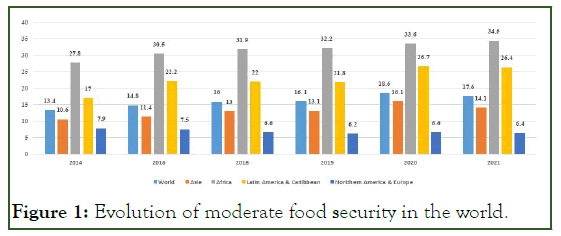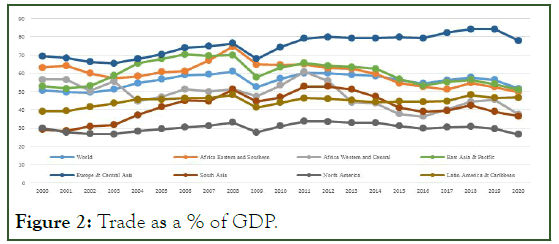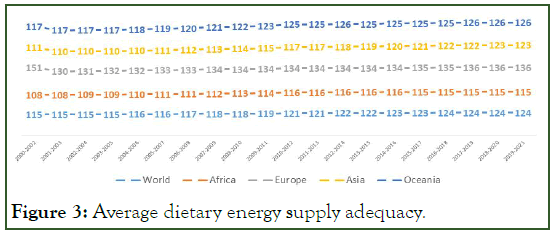Indexed In
- Genamics JournalSeek
- Academic Keys
- JournalTOCs
- China National Knowledge Infrastructure (CNKI)
- Access to Global Online Research in Agriculture (AGORA)
- Centre for Agriculture and Biosciences International (CABI)
- RefSeek
- Directory of Research Journal Indexing (DRJI)
- Hamdard University
- EBSCO A-Z
- OCLC- WorldCat
- Scholarsteer
- SWB online catalog
- Publons
- Euro Pub
- Google Scholar
Useful Links
Share This Page
Journal Flyer

Open Access Journals
- Agri and Aquaculture
- Biochemistry
- Bioinformatics & Systems Biology
- Business & Management
- Chemistry
- Clinical Sciences
- Engineering
- Food & Nutrition
- General Science
- Genetics & Molecular Biology
- Immunology & Microbiology
- Medical Sciences
- Neuroscience & Psychology
- Nursing & Health Care
- Pharmaceutical Sciences
Review Article - (2023) Volume 14, Issue 6
Trade Openness and Food Security: A Critical Review
Kodjo Theodore Gnedeka1* and Kwami Ossadzifo Wonyra22Department of Economics and Management, University of Kara, Kara, Togo
Received: 17-Jan-2023, Manuscript No. JFPT-23-19586 ; Editor assigned: 20-Jan-2023, Pre QC No. JFPT-23-19586 (PQ); Reviewed: 03-Feb-2023, QC No. JFPT-23-19586 ; Revised: 14-Apr-2023, Manuscript No. JFPT-23-19586 (R); Published: 21-Apr-2023, DOI: 10.35248/2157-7110.23.14.1025
Abstract
Economic theory presents trade openness as a factor that promotes economic growth and food security. This article reviews the current work and trends in the relationship between trade openness and food security. The review reveals that food security is a multidimensional concept and the relationship between food security and trade openness is not systematic. The study concludes that the positive effect seems to outweigh the negative effect as the current trend of analysis using a dynamic model has led to positive conclusions underlining the importance of the choice of analysis model. The study shows that the problem of food security is of concern in developing countries in this case.
Keywords
Food security; Trade openness; Developing countries; Economic growth; Food security
Introduction
Trade openness plays an important role in the economic growth and food security of countries, especially developing ones. The importance of trade openness has resurfaced in recent years, especially with the advent of COVID-19 in 2019. Indeed, the COVID-19 pandemic has caused enormous damage to food security, particularly its accessibility. It has caused the closure of land and air borders, confinements etc. These measures taken to eradicate the pandemic coupled with the Ukrainian war have amplified the problem of food security [1]. They have not only caused the price of agricultural inputs, in this case fertilisers, to double or even triple in price on the market Malpass, et al. but also the price of foodstuffs. There are also voluntary restriction measures by countries under the pretext of future reserves [2].
Despite the damage done by the disruption of international trade alone in recent years, the literature remains inconclusive on the effect of trade openness on food security, both empirically and theoretically. In order to enable policy makers, researchers and other actors to have an idea of the current state of this effect, this paper aims to provide readers with organised work and current trends on the relationship between trade openness and food security taking into account these different dimensions [3-6]. The rest of this paper is organised as follows: Section 2 presents the definition of the concepts and some stylized facts. Section 3 presents the results of various previous works on trade openness and food security. Section 4 concludes [7].
Literature Review
Stylized concepts and facts
Definition of concepts and measurement
Food security: Food security is a concept whose definition varies over time and at the level of analysis, i.e. at the household or individual or country level. At the national level, food security tends to focus on the supply side. However, food availability does not mean better accessibility of food to the population. Thus, in the 1970’s, the concept was extended to the accessibility dimension, taking into account preferences and nutritional value [8]. Finally, food security is defined by the FAO, et al. as existing when all people, at all times, have physical and economic access to sufficient, safe and nutritious food to meet their dietary needs and food preferences for an active and healthy life. This definition thus highlights four dimensions of food security. These are availability, accessibility, utilization and sustainability. Thus, several indicators are used to capture the concept of food security. Over the years, more than 450 indicators have been used in the literature. Recent literature uses indicators such as average dietary energy supply adequacy, average protein supply, per capita food supply variability and share of dietary energy supply derived from cereals [9]. Roots and tubers as indicators of food security.
Trade openness: Like food security, trade openness also remains a broad concept. It has been defined in the economic literature by several authors and in various ways. However, the definition that seems to be agreed upon by all considers trade openness as the progressive lowering of tariffs and the elimination of other restrictions on the free movement of goods and services (quotas, standards, decrees and orders, subsidies, import licenses, etc.). Most international organisations (IMF, World Bank, WTO, FAO etc.) use the trade openness rate as a measure of trade openness. In recent literature, it is also captured by globalisation, the number of days needed to declare imports to customs, the weighted average applied tariff rate of all products Golo, et al. etc.
Stylized facts about food security and trade openness
Worldwide, between 702 million and 828 million people were hungry in 2021. In Africa, the situation worsened between 2019 and 2020, reaching 248 million people in 2021. In addition, more than half of the population is severely or moderately food insecure [10]. Worldwide, 30% of the population remains affected FAO, et al. and 46 countries need external food assistance, of which about 75% are African countries FAO, et al.
As shown in Figure 1 that the problem of food security remains highest in Africa followed by Latin America and the Caribbean. A closer analysis of this graph shows that worldwide in general, the trend of this rate is upwards underlining the need to take urgent action if we are to achieve the goal of zero hunger. The analysis of Figures 2 and 3 shows that trade openness is a potential factor in decision-making [11].

Figure 1: Evolution of moderate food security in the world.
Source: Authors based on FAO, 2022.

Figure 2: Trade as a % of GDP.
Source: Authors from WDI, 2022.

Figure 3: Average dietary energy supply adequacy.
Source: Authors from FAOSTAT, 2022.
Trade openness and food security
Since the seminal works of Smith, et al.; Ricardo, et al. the problem of the effect of trade openness on various aspects of the economy, in this case food security, has attracted a number of researchers who have made it a priority field of investigation [12-14]. However, a reading of the theoretical and empirical work reveals contradictions. Indeed, there are two opposing theses: The heterodox thesis and the orthodox thesis.
Trade openness as a factor in food security
This thesis is defended by the heterodox. For the latter, trade openness positively affects food security through several channels: The availability, diversity and quality of food, the increase in the supply of inputs and externalities, accessibility and the transfer of technology [15].
Availability of food products: Economic theory suggests that countries facing a food supply constraint will tend to import more food from the rest of the world to meet their food needs. Supply constraints can arise from a number of factors including climate change, technology shocks, and population growth. In this context, trade openness allows deficit nations to import from economies with surplus food supplies. These imports or exports reinforce food availability, which is a necessary condition for food security.
Diversity and quality of food: Trade openness is beneficial for both consumers and producers. Indeed, trade openness allows consumers not only access to new markets, but also to a greater variety of quality products at lower cost. Their level of satisfaction increases and leads to an increase in the elasticity of demand for consumer goods. This competitive shock resulting from trade openness requires companies to reduce their trade margins, particularly by lowering prices [16]. The capacity to increase diversity is likely to be greatest for small countries that lack agro-ecological diversity. In addition, companies are forced to provide high quality ranges of food and non-food goods in order to sell them on international markets. Trade openness thus has a positive influence on food security as it promotes food diversity and quality.
Increasing the supply of inputs and externalities: In an open economy, producers have greater flexibility in the supply of intermediate consumption goods and other inputs or factors of production necessary for their activities. This greater variety of inputs ensures a more efficient production mix. The differentiated production can be used as final consumption goods or intermediate consumption goods, which is a cage for food security. This is the quality effect of trade openness [17].
Accessibility and technology transfer: Trade openness is an important factor for agricultural technology transfer, income enhancement and lower commodity prices. Indeed, studies have shown that trade openness is a source of agricultural technology transfer. This transfer will improve agricultural productivity. Thus, through better productivity, income is likely to improve. The income effect also makes other products more accessible [18]. In addition, productivity can have a downward effect on the price of products and consequently on food security.
Some empirical work has confirmed the positive relationship between trade openness and food security. This is the case of Fuller, et al.; Pyakuryal, et al.; Thomas, et al.; Gillson, et al.; Clapp, et al.; Baldos, et al.; Dame, et al.; Hawkes, et al.; Geyik, et al.; and Baylis, et al. This is also the case for Dithmer, et al. in 151 countries worldwide [19]. Indeed, through the GMM estimation method in system, the authors have shown that trade openness positively and significantly affects food energy consumption. The same result is also obtained by Hoddinott, et al. in 10 developing and middle-income countries around the world. Fusco, et al. using a dynamic panel over the period 2000 to 2017, showed that trade openness has a net positive effect on food security. The same finding is observed in the work of Gnedeka, et al.
Trade openness does not necessarily promote food security
In contrast to the first thesis, the pessimists argue that trade openness has a negative or mixed effect on food security. According to this view, trade openness poses a threat to food security for several reasons.
Firstly, trade openness can hinder diversification and lead to unsustainable development. It can also increase the vulnerability of countries due to their dependence on international trade while weakening the position of agricultural producers in some developing countries. Second, trade openness reshapes the global food supply chain by favoring multinational companies while depriving states of their resources. Third, trade openness can have economic impacts. For example, international trade in agricultural products can have profound effects on the environment, nutrition and people's health [20].
Discussion
In effect, trade openness implies the specialization of economies by taking into account their comparative advantage. It therefore implies an international division of the labour factor. This is a problem insofar as the agricultural sector in Sub-Saharan Africa is not able to respond to price signals, which is the hypothesis supporting trade openness. Moreover, the competitiveness of an economy in a sector depends on policy choices. The policies especially in the agricultural sector of developing countries remain subject to many shocks; this does not allow them to have a comparative advantage in this sector. As a result, these countries will become net importers of food. To ensure their food security, they are therefore obliged to import food products from other regions, especially those that have benefited from trade openness. Among the advocates of this thesis are Schutter, et al.; Bush, et al.; Rosset, et al.; Wittman, et al.; Sakuyama, et al.; and Potter, et al. etc.
Some empirical studies have confirmed this view. Indeed, no significant effect is found between trade openness and food availability in some African countries. On the other hand, some authors such as Bezuneh, et al.; Herath, et al.; and Mary, et al. have found a negative effect. In a comparative study of CEMAC and UEMOA countries over the period 1987 to 2014, Assoumou-Ella, et al. found that overall trade openness has a negative effect on their food security. On the other hand, if only availability is taken into account, there is a visible effect of trade openness. Finally, the work of Rahman, et al. found mixed results for South Asian countries.
Conclusion
The results of the research presented in this paper allow us to conclude that an improvement in the level of openness of the country leads, ceteris paribus, to the import of food products from countries in excess to those in deficit. In doing so, trade openness improves the food security of countries through availability, accessibility, stability and utilizations as a whole. The work presented also allowed us to deduce that there is a lack of consensus on the analysis of the effects of trade openness on food security. The contradictions observed can be explained in general by three fundamental reasons. The multi-dimensionality of the concepts of food security and trade openness. The choice of methods, period and contexts for analyzing the concepts.
Finally, most previous studies have used poverty indicators instead of real food security indicators. The lack of consensus on the empirical and theoretical level and all that follows from this underlines the need to dig deeper into the subject to better understand the relationship between the two variables, especially in a context where the achievement of the SDGs seems to be a failure.
References
- Bai Y, Alemu R, Block SA, Headey D, Masters WA. Cost and affordability of nutritious diets at retail prices: Evidence from 177 countries. Food policy. 2021;99:101983.
[Crossref] [Google Scholar] [PubMed]
- Baldos UL, Hertel TW. The role of international trade in managing food security risks from climate change. Food Secur. 2015;7:275-290.
- Baylis K, Fulton ME, Reynolds T. The political economy of export restrictions: The case of Vietnam and India. Front Econ Glob. 2016;16:177-197.
- Bene C, Bakker D, Chavarro MJ, Even B, Melo J, Sonneveld A. Global assessment of the impacts of COVID-19 on food security. Glob Food Sec. 2021;31:100575.
[Crossref] [Google Scholar] [PubMed]
- Bezuneh M, Yiheyis Z. Has trade liberalization improved food availability in developing countries? An empirical analysis. 2009.
- Bezuneh M, Yiheyis Z. The effect of trade liberalization on food security: The experience of selected African countries. J Afr Dev. 2012;14(1):13-26.
- Bezuneh M, Yiheyis Z. Has trade liberalization improved food availability in developing countries? An empirical analysis. J Econ Dev. 2014;39(1):63.
- Chen B, Feng Y. Determinants of economic growth in China: Private enterprise, education, and openness. China Econ Rev. 2000;11(1):1-5.
- Clapp J. Food security and contested agricultural trade norms. J Intl L Intl Rel. 2015;11:104.
- Dame J. Food security and translocal livelihoods in high mountains: Evidence from Ladakh, India. Mt Res Dev. 2018;38(4):310-322.
- Dithmer J, Abdulai A. Does trade openness contribute to food security? A dynamic panel analysis. Food Policy. 2017;69:218-230.
- Edwards S. Openness, trade liberalization, and growth in developing countries. J Econ Lit. 1993;31(3):1358-1393.
- Ekodo R, Ngomsi A. Ouverture Commerciale Et Croissance Economique En Zone CEMAC. J Econ Dev Studies. 2017;5(3):58-67.
- Ethier WJ. National and international returns to scale in the modern theory of international trade. Am Econ Rev. 1982;72(3):389-405.
- Fuller F, Beghin J, de Cara S, Fabiosa J, Fang C, Matthey H. China's accession to the world trade organization: What is at stake for agricultural markets?. Appl Econ Perspect Policy. 2003;25(2):399-414.
- Fusco G, Coluccia B, de Leo F. Effect of trade openness on food security in the EU: A dynamic panel analysis. Int J Environ Res Public Health. 2020;17(12):4311.
[Crossref] [Google Scholar] [PubMed]
- Geyik O, Hadjikakou M, Karapinar B, Bryan BA. Does global food trade close the dietary nutrient gap for the world's poorest nations?. Glob Food Sec. 2021;28:100490.
- Guerrieri P, Vergara Caffarelli F. Trade openness and international fragmentation of production in the European Union: The new divide?. Rev Int Econ. 2012;20(3):535-551.
- Hassine NB, Kandil M. Trade liberalisation, agricultural productivity and poverty in the Mediterranean region. Eur Rev Agric Econ. 2009;36(1):1-29.
- Kent K, Alston L, Murray S, Honeychurch B, Visentin D. The impact of the COVID-19 pandemic on rural food security in high income countries: A systematic literature review. Int J Environ Res Public Health. 2022;19(6):3235.
[Crossref] [Google Scholar] [PubMed]
Citation: Gnedeka KT, Wonyra KO (2023) Trade Openness and Food Security: A Critical Review. J Food Process Technol. 14:1025.
Copyright: �© 2023 Gnedeka KT, et al. This is an open access article distributed under the terms of the Creative Commons Attribution License, which permits unrestricted use, distribution, and reproduction in any medium, provided the original author and source are credited.


